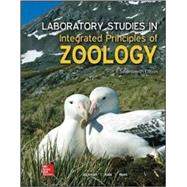PART ONE
INTRODUCTION TO THE LIVING ANIMAL
EXERCISE 1
The Microscope 3
Exercise 1A: Compound Light Microscope 3
Exercise 1B: Stereoscopic DissectingMicroscope 8
Exercise 1C: Electron Microscope 9
EXERCISE2
Cell Structure and Division 13
Exercise 2A: The Cell—Unit of ProtoplasmicOrganization 13
Exercise 2B: Cell Division—Mitosis andCytokinesis 16
EXERCISE3
Gametogenesis and Embryology 25
Exercise 3A: Meiosis—Maturation Division ofGerm Cells 25
Exercise 3B: Cleavage Patterns—Spiral and RadialCleavage 36
Exercise 3C: Frog Development 44
EXERCISE4
Tissue Structure and Function 47
Exercise 4: Tissues Combined into Organs 54
PARTTWO
THEDIVERSITY OF ANIMAL LIFE
EXERCISE5
Ecological Relationships of Animals 63
Exercise 5A: A Study ofPopulation Growth, with Application of the Scientific Method 63
Exercise 5B: Ecology ofa Freshwater Habitat 67
EXERCISE6
Introduction to Animal Taxonomy 77
Exercise 6A: PhylogenyReconstruction—How to Make a Cladogram 78
Exercise 6B: Use of aTaxonomic Key for Organism Identification 83
EXERCISE7
Unicellular Eukaryotes 89
Exercise 7A: PhylumAmoebozoa—Amoeba and Others 89
Exercise 7B: PhylaEuglenozoa and Viridiplantae—Euglena, Volvox, and Trypanosoma 97
Exercise 7C: PhylumApicomplexa—Plasmodium and Gregarina 106
Exercise 7D: PhylumCiliophora—Paramecium and Other Ciliates 109
Experimenting inZoology: Effect of Temperature on the Locomotor Activity of Stentor 115
Experimenting inZoology: Genetic Polymorphism in Tetrahymena 117
EXERCISE8
The Sponges 121
Exercise 8: Class Calcispongiae—Sycon 121
EXERCISE9
The Radiate Animals 131
Exercise 9A: Class Hydrozoa— Hydra, Obelia, and Gonionemus132
Exercise 9B: Class Scyphozoa—Aurelia, a “True” Jellyfish138
Exercise 9C: Class Anthozoa— Metridium, a Sea Anemone,and Astrangia, a Stony Coral 140
Experimenting in Zoology: Predator Functional Response: FeedingRate in Hydra 147
EXERCISE10
The Flatworms 149
Exercise 10A: Class Turbellaria— Planarians 150
Exercise 10B: Class Trematoda— Digenetic Flukes 153
Exercise 10C: Class Cestoda— Tapeworms 158
Experimenting in Zoology: Planaria Regeneration Experiment 167
EXERCISE11
Nematodes and Four Small Protostome Phyla 171
Exercise 11A: Phylum Nematoda —Ascaris and Others 172
Exercise 11B: A Brief Look at Some Other Protostomes 179
EXERCISE12
The Molluscs 183
Exercise 12A: Class Bivalvia = Pelecypoda)—Freshwater Clam 184
Exercise 12B: Class Gastropoda—Pulmonate Land Snail 191
Exercise 12C: Class Polyplacophora— Chitons 194
Exercise 12D: Class Cephalopoda—Loligo, theSquid 195
EXERCISE 13
The Annelids 201
Exercise 13A: Class Errantia— Clamworm 202
Exercise 13B: Class Sedentaria Earthworm 204
Exercise 13C: Family Hirudinidae— Leech 215
Experimenting in Zoology: Behavior of Medicinal Leeches, Hirudomedicinalis 217
EXERCISE14
The Chelicerate Arthropods 219
Exercise 14: Chelicerate Arthropods—Horseshoe Crab and Garden Spider 220
EXERCISE15
The Crustacean Arthropods 227
Exercise 15A: Subphylum Crustacea— Crayfish,Lobsters, and Other Crustaceans 227
Experimenting in Zoology: The PhototacticBehavior of Daphnia 239
EXERCISE16
The Arthropods 241
Exercise 16A: Myriapods—Centipedes andMillipedes 241
Exercise 16B: Insects—Grasshopper andHoneybee 243
Exercise 16C: Insects—House Cricket 251
Exercise 16D: Metamorphosis of Drosophila254
Exercise 16E: Collectionand Classification of Insects 255
EXERCISE 17
The Echinoderms 265
Exercise 17A: Class Asteroidea—Sea Stars 266
Exercise 17B: Class Ophiuroidea—Brittle Stars 270
Exercise 17C: Class Echinoidea—Sea Urchins 273
Exercise 17D: Class Holothuroidea—Sea Cucumbers 275
Exercise 17E: Class Crinoidea—Feather Stars and Sea Lilies 278
EXERCISE18
Phylum Chordata: A Deuterostome Group 281
Exercise 18A: Subphylum Urochordata— Ciona, an Ascidian283
Exercise 18B: Subphylum Cephalochordata—Amphioxus 285
EXERCISE19
The Fishes—Lampreys, Sharks, and Bony Fishes 291
Exercise 19A: Class Petromyzontida— Lampreys (Ammocoete Larvaand Adult) 291
Exercise 19B: Class Chondrichthyes— Cartilaginous Fishes 296
Exercise 19C: Class Actinopterygii—Bony Fishes 301
Experimenting in Zoology: Agonistic Behavior in Paradise Fish, Macropodusopercularis 307
Experimenting in Zoology: Analysis of the Multiple Hemoglobin System in Carassiusauratus, Common Goldfish 309
EXERCISE 20
The Amphibians: Frogs 313
Exercise 20A: Behavior and Adaptations 314
Exercise 20B: Skeleton 318
Exercise 20C: Skeletal Muscles 320
Exercise 20D: Digestive, Respiratory, and Urogenital Systems 325
Exercise 20E: Circulatory System 328
Exercise 20F: Nervous System 334
EXERCISE21
The Reptiles 337
Exercise 21 Painted Turtle 337
EXERCISE22
The Birds 343
Exercise 22 Pigeon 343
EXERCISE23
The Mammals: Fetal Pig 349
Exercise 23A: Skeleton 350
Exercise 23B: Muscular System 354
Exercise 23C: Digestive System 363
Exercise 23D: Urogenital System 368
Exercise 23E: Circulatory System 372
Exercise 23F: Nervous System 379
Exercise 23G: Respiratory System 384
Appendix A: Instructor’s Resources for Implementing Exercises387
Appendix B: Sources of Living Material and Prepared Microslides420








